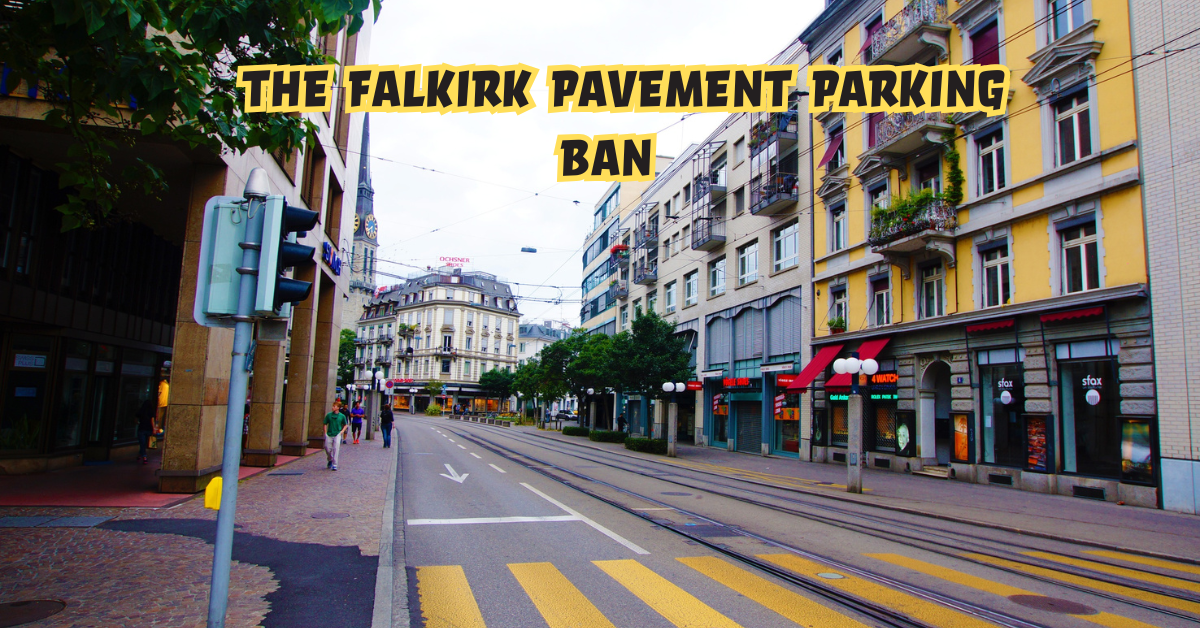The Falkirk pavement parking ban has raised questions among residents, drivers, pedestrians, and local businesses who want to understand how this change affects daily life. Within its first announcement, people began searching for clarity: Will I still be allowed to park on narrow streets? Who will issue penalties? Is this ban about safety or revenue collection? The intention of this article is to clarify exactly what the ban means, who it affects, and how Falkirk’s streets are expected to change over time. This is less about punishment and more about reshaping urban behaviour, prioritizing pedestrians, and redefining how communities share their public spaces.
The Evolution of Pavement Use in Falkirk
Pavements have traditionally been considered a pedestrian-only space. However, over decades, increasing car ownership gradually blurred that boundary. Many residents began using pavements as overflow parking areas, especially in older neighbourhoods built before mass automobile ownership. What began as a temporary convenience slowly transformed into an accepted norm. In many streets, pavements became extensions of private driveways, even though they remain public property meant for safe pedestrian movement.
Parents pushing prams, elderly residents using mobility aids, and visually impaired individuals often found pavements obstructed. They were forced to step onto the road, exposing themselves to risk. While complaints existed, enforcement remained inconsistent.
The Falkirk pavement parking ban marks a turning point. Instead of relying on public courtesy, it introduces a clear legal framework that prioritizes foot traffic over vehicle convenience. Authorities argue that pavements should restore their original purpose: to protect the vulnerable and promote walking culture.
Why Falkirk Introduced the Ban
Falkirk Council acknowledged several triggers that made regulation inevitable:
- Pedestrian safety concerns from repeated reports of blocked pavements.
- An aging population needing wider, accessible walking paths without obstructions.
- Pressure from disability advocacy groups calling for equity in street design.
- Urban redesign goals aiming to improve walking-friendly environments to reduce car dependency.
- Alignment with national policies, as other Scottish regions begin adopting similar parking restrictions.
Rather than reacting to complaints episodically, the Falkirk policy aims to build lasting behavioural change. By setting a consistent rule, it leaves less room for interpretation.
Understanding the Key Elements of the Ban
Unlike informal restrictions, this ban is legally enforceable, meaning it comes with penalties, monitoring responsibility, and long-term accountability.
Key pillars include:
- Parking on pavements is prohibited unless explicitly marked as permitted.
- Enforcement is continuous, not limited to office hours.
- Both civil enforcement officers and digital monitoring will contribute to oversight.
- All streets are assumed restricted unless listed as exempt due to spatial constraints.
This approach introduces clarity. Residents no longer need to guess; the assumption is straightforward — pavements are for people.
Community Reaction: Divided but Thoughtful
Reactions have ranged from frustration to relief. Some residents see it as an inconvenience that limits parking flexibility, especially in crowded residential clusters. Others appreciate a return to orderly street design that respects pedestrians.
Falkirk has a strong community identity, and most residents understand that shared space requires compromise. Discussions at local forums revealed a recurring theme: “If pavements are for everyone, should convenience override safety?”
Economic Reflections from Local Business Owners
Business owners in high-footfall zones expressed concerns that strict enforcement could deter quick-stop customers. However, urban economists often argue that walkable streets increase business visibility, encourage lingering foot traffic, and invite tourists. In similar towns, businesses initially worried about restrictions later reported improved shopping atmospheres free from vehicle clutter.
Falkirk could experience a similar shift. Rather than drivers blocking storefronts, pavements could become spaces used for seating, seasonal décor, small community stalls, or simply unobstructed movement.
Balancing Enforcement and Education
The success of this initiative will not depend solely on issuing penalty tickets. Sustainable change requires a combination of education, awareness campaigns, digital mapping tools, and signage. Without clear communication, even well-intentioned drivers may unknowingly violate rules.
Local authorities are expected to use online portals, neighbourhood signage, and community outreach sessions to help residents adapt. The goal is not to punish but to reshape norms.
Technology and Smart Monitoring
Modern enforcement strategies include ANPR cameras (Automatic Number Plate Recognition), mobile enforcement units, and digital reporting apps. By integrating technology, Falkirk seeks to ensure fairness and consistency.
Residents will likely gain access to mobile tools where they can view legal parking maps, submit concerns, and check penalty statuses. This digital layer aligns with modern governance practices, reducing arguments over selective enforcement.
Impact on Disability Inclusion
Among all beneficiaries, disabled residents stand to gain the most. Pavement blockages force wheelchair users into the road, turning a basic outing into a high-risk experience. The ban re-centers pavement design around inclusivity.
An accessible Falkirk is also a more socially cohesive Falkirk. When elderly citizens or disabled individuals feel confident navigating streets, community life naturally expands. Social isolation decreases, and civic participation rises.
Cultural Shift: From Car-First to People-First
For years, urban planners promoted car-accessibility as a marker of progress. Today, mobility thinking has evolved. Progress is now defined by how freely people can walk, cycle, or move without fear. The Falkirk pavement parking ban signals a broader philosophical change: cars are guests in the public space, not owners of it.
This does not mean cars are unwelcome. Rather, their place is defined through structure, planning, and respect for non-drivers.
Comparative View: What Other Towns Teach Us
Other UK localities implementing pavement parking bans offer lessons:
- Edinburgh saw a surge in resident complaints before compliance improved.
- Brighton used public art and pavement redesign to make walking inviting.
- York collaborated with local schools to educate families about safe drop-off zones.
Falkirk can adopt a hybrid approach: firm enforcement with community creativity, using pavement design as a canvas instead of a parking extension.
Anticipated Road User Behaviour
Behavioural experts predict three possible adaptations:
- Increased off-street parking investment, including driveway expansions.
- Greater use of car-sharing or public transit.
- Shift to short-term parking zones with timed restrictions instead of permanent roadside parking.
These behavioural changes could reduce traffic congestion over time and encourage sustainable mobility habits.
Effect on Property Planning and Urban Design
Architects and property developers will likely respond to new norms by designing homes with integrated parking bays and widened pedestrian zones. Pavement design could evolve, using visual elements to make illegal parking visually awkward or physically impossible through bollards and textured paving.
Possible Challenges Ahead
Not all streets in Falkirk have adequate space for legal on-road parking. Narrow historic lanes pose a special challenge. Councils may implement a temporary exemption framework but will require residents to engage in dialogue to find workable alternatives.
Another challenge lies in public perception. Strict enforcement without empathy risks being viewed as revenue-driven. However, fair communication, visible reinvestment in pavement improvements, and transparency around collected penalty data could build trust.
Looking Ahead: What Success Might Look Like
A successful Falkirk pavement parking ban would produce several visible outcomes:
- Pavements consistently clear for all age groups and mobility levels.
- Public trust in street management improving due to consistent enforcement.
- Increase in pedestrian movement and reduction in road anxiety.
- Businesses adjusting pavement use for aesthetic and commercial benefit.
- Local pride in urban space, where pavements feel inviting rather than obstructed.
Falkirk could become a reference point for balanced urban policy in Scotland.
Frequently Asked Questions
1. Will every street in Falkirk be included in the pavement parking ban?
By default, yes. All pavements are considered restricted unless marked otherwise. However, a shortlist of streets with structural constraints may receive conditional exemptions following council assessment.
2. How will drivers know which areas allow pavement parking?
Clear signage, digital maps, and community announcements will accompany the rollout. Residents are encouraged to check official local channels and use council-published parking maps once available.
3. What happens if I park partially on the pavement just to let a vehicle pass?
Even partial pavement obstruction may result in a penalty unless signage grants exception. The enforcement approach is based on pavement usability, not driver intent.
4. Will penalties increase for repeat offenders?
Yes, discussions suggest increasing tariffs for repeat violations to discourage chronic misuse. First-time warnings may occur during the transition phase, but enforcement will tighten quickly.
5. Can community members report pavement parking violations?
Digital reporting channels are expected to be integrated, allowing residents to file photographic reports that officers review. This ensures community participation in maintaining accessible public space.











